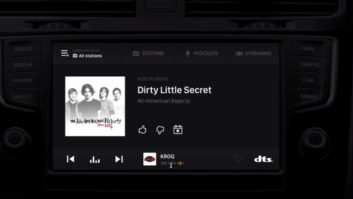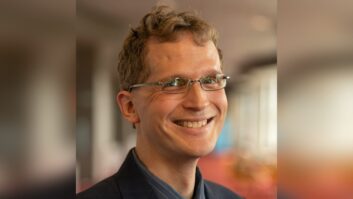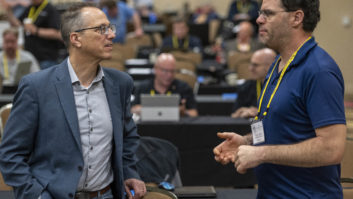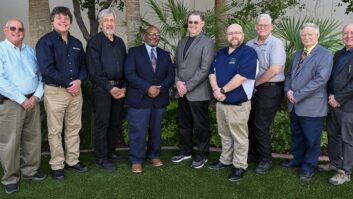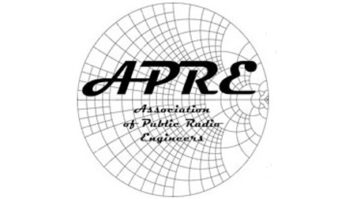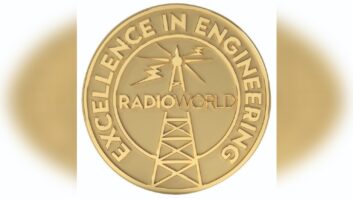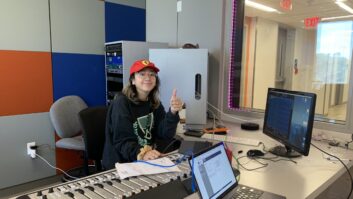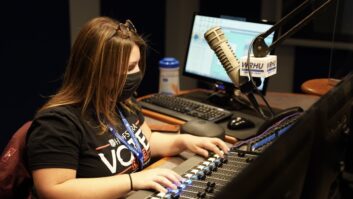Paul McLane is U.S. editor in chief.
Why did the master FM antenna system at the Empire State Building fail for the first time since its installation in the early 1990s? How can radio stations add visual communications to their broadcasts? How do new consumer devices affect the job of a radio engineer?
These are some of the topics that will be brought up in the Broadcast Engineering Conference of the spring NAB Show. More details have become public about the agenda; and while some of the speakers and topics are familiar, I think it’s shaping up to be another good show from the BEC organizers. Let’s face it, it’s probably not easy to keep coming up with fresh material year after year. Kudos to the selection committee and the event chairs. Here’s what jumps out at me as being of interest to radio attendees.
Saturday’s traditional Ennes sessions, presented with SBE, will focus on “Infrastructure: Keeping It Going in Challenging Times,” chaired by Fred Baumgartner of Harris and consultant Tom Mikkelsen. Presentations include an infrastructure tutorial; a discussion of “broadcast engineering in modern economic times” with Chris Imlay of Booth, Freret, Imlay & Tepper; a presentation by John Bisset of Tieline and Radio World about “keeping it going in the real world”; and presentations about IT infrastructure, tower management, disaster recovery and transitioning to IPv6.
Sunday, the discussion “Adding Visual Communications to Radio Broadcasts” is among those in sessions about “The Future of Radio Broadcasting” chaired by Dom Bordonaro of Cox Radio. Speakers also include Pierre Robidoux of CBC/Radio-Canada; Andrew Janitschek of Radio Free Asia; Tom Hartnett of Comrex; and Chip Jellison of RCS. Topics include audio content collection; something called “applets and craplets”; and migrating call-in radio shows to wideband audio.
On Sunday afternoon, the Broadcast Engineering Conference will discuss “Improving HD Radio.” Steve Fluker of Cox Media Group chairs. One session will look at “PAPR and Asymmetrical Sidebands Field Results,” presented by Nautel, NPR Labs and WAMU(FM). In another, public radio engineers discuss “A Standardized Method for Radio Program Service Data Distribution.” Other speakers from Dielectric, Broadcast Electronics and Nautel will discuss developments in master FM antenna systems, elevated HD Radio power, IBOC quality metrics and related topics.
A Monday afternoon session chaired by Greg DePriest of NBC Universal will explore “Mission-Critical IT for Broadcast.” One session helps engineers decode the panoply of IT-related acronyms and technologies. Steve Lampen of Belden explores “10 Gigabit Networking for Audio and Video,” while John Lindsay of APT discusses “Seamless Audio Over Imperfect IP.” Tony Peterle of WorldCast Systems talks about using SNMP in broadcast facility control. Bryan Jones of Broadcast Electronics and Leigh Whitcomb of Harris will address various aspects of working with IP networks.
Tuesday, Glynn Walden of CBS Radio chairs a radio engineering forum. (Remember that CBS and NAB were somewhat “on the outs” for most of the past decade. With CBS back in the NAB membership fold, it’s nice to see high-visibility participation in this conference from CBS technical people — although Glynn hasn’t exactly been absent from past shows.)
In the morning, Ron Rackley will take about an approach to improving AM directional antenna pattern performance. Ben Dawson addresses “Antenna Base Region Geometry and Voltage Sampling Techniques for Moment Method AM Directional Antenna Proofs.” John Warner of Clear Channel will discuss MoM methodology as applied to the array design process. Tom King of Kintronic will talk about an interesting project at WAOK(AM) using a mix of guyed and self-supporting towers. Andy Skotdal, whose adventures at AM station KRKO have been widely reported, will discuss his project and the associated land-use litigation and vandalism. Gary Smith of Bonneville will talk about building an AM array on a landfill.
Tuesday afternoon, the engineering forum continues with discussion of monitoring and control systems by Kerry Cozad of Dielectric; radio engineering on a budget by Randy Woods of Z88.3 Radio; field trials of various digital radio technologies by Yong-Tae Lee of ETRI; performance analysis with DRM+ from Jens Schroeder of RFmondial; automation strategies with Ray Miklius of BE; the role of design codes in tower planning with Dave Davies of ERI; adding IFB to an RPU with engineer Bill Ruck; a discussion of bend radius in cable with Steve Lampen of Belden; and a discussion of a “new approach to solid-state high-power FM amplifiers” from George Cabrera and Tim Anderson of Harris.
Wednesday sessions feature regulatory issues for engineers. A morning panel about EAS features speakers from Sage Alerting Systems, Global Security Systems and Digital Alert Systems. Contract engineer Jim Dalke will discuss what to do when “the inspector comes knocking.” The Technology Luncheon will feature presentation of the NAB Engineering Achievement Awards and Technology Innovation Awards.
Wednesday afternoon brings sessions exploring “Emergency Operations: Planning & Implementation,” chaired by Jim Stagnitto of WYNC/WQXR Radio. Among others, David Brender of the Copper Development Association will give case histories in lightning protection and grounding. Keith Graham will talk about business continuity or “keeping the lights on.” Kevin Rodgers of Nautel will discuss “proactive transmitter service and support strategies” while his colleague Wendell Lonergan will talk about N+1 technology. In what is likely to be a popular session, Joe Giardina of DSI RF Systems will delve into that failure at the master FM antenna at Empire.
Wednesday also will explore “Internet-Enabled Radio and Television,” a series of papers chaired by Steve Davis of Clear Channel. Speakers will appear from Harris Corp., NHK (Japan Broadcasting Corp.), Weather Central and Verimatrix. Davis will also chair presentations from WorldCast Systems, Citadel Broadcasting and The Radio Experience about RDS implementation. The ever-popular annual Amateur Radio Operators Reception again takes place Wednesday evening at the Las Vegas Hilton. And Thursday sessions delve into the impact of consumer devices, green technology and other topics.
This is just a sampling. See the show site for details.





